
Abu Simbel: The 8th Wonder of the Ancient World?
Everyone loves a good listicle. Top 10…. you name it… that list probably exists out there somewhere on the internet. Heck, put together a list of the world’s top 15 toilets, and even that will go viral. But these kinds of lists existed long before sites like Buzzfeed ever did. Hellenistic (aka Ancient Greek) tourists over 2,000 years ago had their own list of must-sees. I’m talking about that mother-of-all-listicles, the so-called Seven Wonders of the Ancient World. And, yes, in Egypt you’ll find the only one of those seven wonders still standing proud… the Pyramids of Giza.
However, another ancient wonder can be found in Egypt, far to Cairo’s south. Though it rivals the pyramids in scale and splendor, the Temple of Abu Simbel remained hidden by desert sand until just over 200 years ago. Had Herodotus—the list’s fabled author—known of Abu Simbel’s existence, surely his list of wonders would have extended to eight!
Abu Simbel’s Epic Discovery
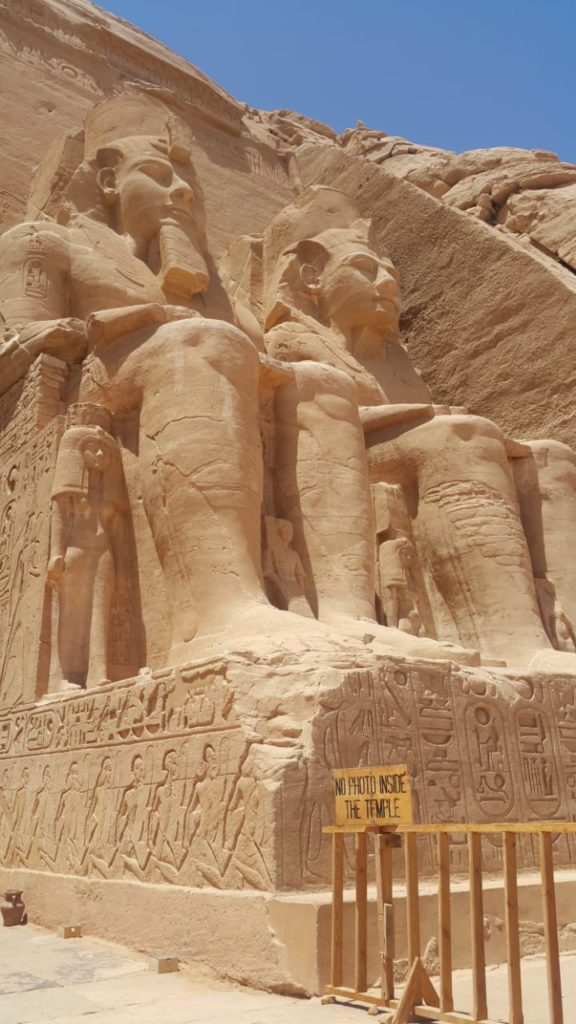 Imagine running into one of these guys buried in the sand! Image by Mohamed Said
Imagine running into one of these guys buried in the sand! Image by Mohamed Said
In 1813, Johann Ludwig Burckhardt, the first explorer to rediscover the lost temple, stumbled upon the heads of some massive statues. He deemed them more beautiful than any ancient Egyptian figure he had yet seen. These statues alone were enough to capture the world’s attention. But when the temple itself was excavated, the full extent of his discovery was probably even beyond his wildest imagination!
It took four years for workers to clear enough sand to uncover the temple entrance. Another two years of excavation passed until the four seated, 10-meter statues of Ramses II were fully revealed. When archaeologists and artists could finally enter, their etchings and notes captivated people everywhere. Egypt-mania swept the world!
Ramses II: His Own Number One Fan
The Temple of Abu Simbel was built around 1260 BC, in honor of Pharaoh Ramses II’s thirtieth year of reign. Its stunning wall art attests to Ramses’ military achievements — a useful way for the pharaoh to convey his power and might to his subjects, and to intimidate his enemies!
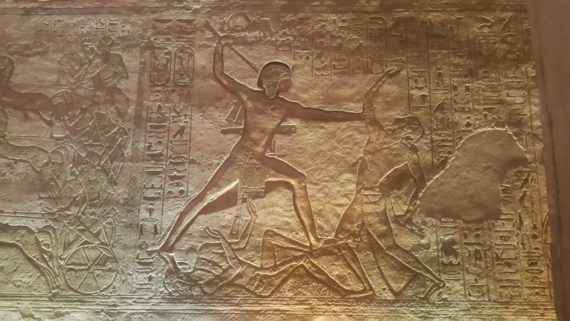 The pharaoh defeats his enemies by Mohamed Said
The pharaoh defeats his enemies by Mohamed Said
Moreover, the temple also served as a vehicle to cement the pharaoh’s god-king status. Images of the pharaoh – statues and reliefs – depict him on par with some of the ancient Egyptians’ most important gods. Besides the four statues of Ramses II guarding the entrance, eight more statues of the pharaoh line the first chamber; another figure of Ramses sits among three other gods in the temple’s sacred, innermost sanctuary.
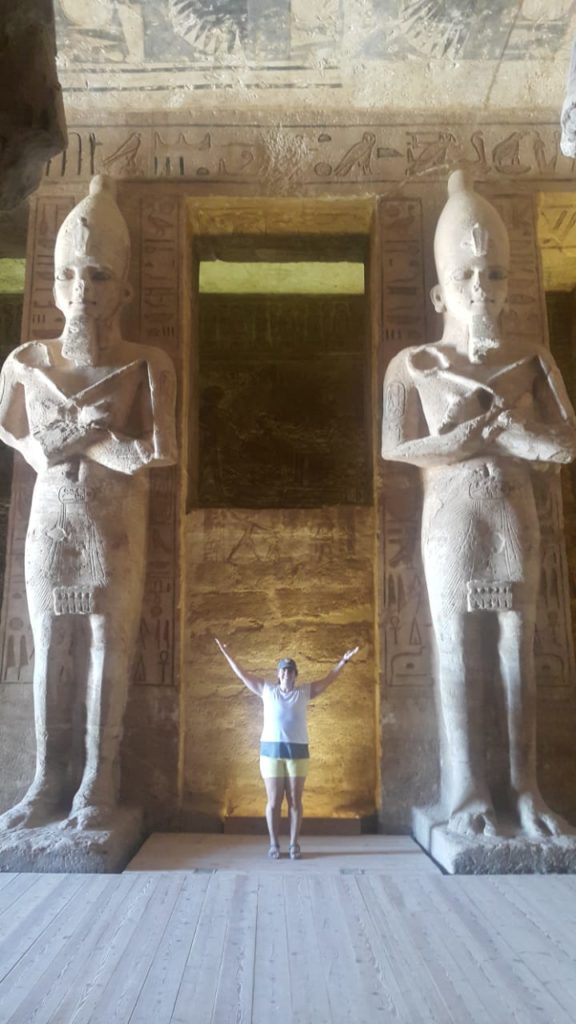 Me with two of the eight nearly identical statues of Ramses II inside the first chamber. For all those occasions when one giant statue of yourself just won’t do… Image by Mohamed Said
Me with two of the eight nearly identical statues of Ramses II inside the first chamber. For all those occasions when one giant statue of yourself just won’t do… Image by Mohamed Said
The Genius of the Ancient Egyptians
Builders carved the entire temple –including its massive facade and towering outer statues – into the face of a stone cliff on the bank of the Nile. That’s certainly a mind-boggling feat of engineering genius, in and of itself. But the scale of the engineering job is only the tip of the metaphorical iceberg, representing the scope of advancement of the ancient society who created this masterpiece.
The ancient Egyptians’ had an absolutely unparalleled understanding of astronomy and the alignment of the sun and stars during different times of the year. (In fact, they used this knowledge to align the Great Pyramid in Giza oriented to true north; to this day, there is no structure on Earth more perfectly aligned than the pyramid. But I digress, back to Abu Simbel…)
A One-of-a-kind Solar Phenomenon
Its builders constructed Abu Simbel in such a way that something pretty amazing happens exactly two days a year. These dates are thought to perhaps have aligned with the pharaoh’s birthday and coronation. On those two days, sunlight reaches back, 60 meters, through two chambers into the innermost sanctum of the temple. There, it washes over three of the four statues: those of Ra-Harakhte, the god-king Ramses II, and Amun-Ra. (Note the names of all these gods – even Ramses – references Ra, the supreme sun-god of ancient Egypt.) The fourth statue is of Ptah, the mysterious creator-god, not of the sun but rather its shadowy source. The enigmatic Ptah remains perpetually sheathed in darkness.
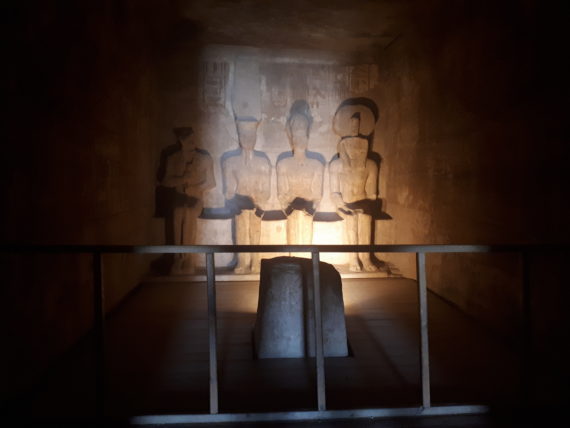 Artificial lighting replicates the solar effect the other 363 days of the year. Image by Christina Wichert
Artificial lighting replicates the solar effect the other 363 days of the year. Image by Christina Wichert
The dates of this celestial alignment are the 22 of February and 22 October, each year. Modern Egypt continues to celebrate this awesome phenomenon with a biannual Sun Festival. On these two days, celebrants and tourists gather before dawn. They witness as the sun rises and first illuminates the temple’s facade, then reaches farther and farther back inside, to finally set the sun-god figures aglow. The lighting only lasts about 20 minutes. The party then continues for the rest of the day with musical and folk-dance performances, food, and a bazaar.
Though the Sun Festival is a one-of-a-kind event, really any time of year is worth traveling to Abu Simbel. The temple complex is truly an impressive sight to behold. Prepare yourself, though; summer months (June through September) can be especially HOT!
Temple of Nefetari/Hathor
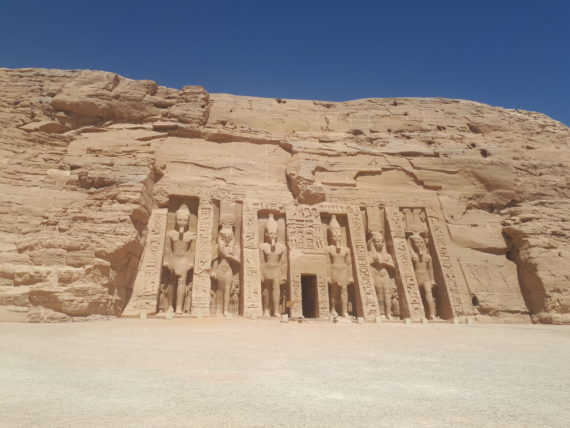 Temple of Nefertari by Christina Wichert
Temple of Nefertari by Christina Wichert
Next to his temple, Ramses had a smaller temple built for his favorite wife, Nefertari. Five colossal seated statues flank its entrance: three of Ramses and two of the queen Nefertari. Inside, artwork depicting the royals presenting offerings to many of their gods covers the walls. Particularly featured is the cow-headed mother goddess, Hathor.
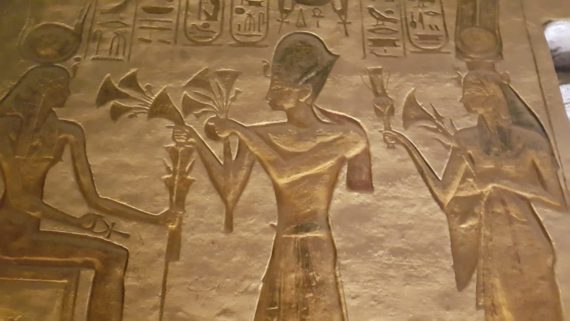 Artwork depicting the royals presenting offerings to many of their gods covers the walls. Image by Mohamed Said
Artwork depicting the royals presenting offerings to many of their gods covers the walls. Image by Mohamed Said
Like all the best things in life that don’t come easy, getting to Abu Simbel takes some dedication. It’s remote location – sitting atop a cliff overlooking Lake Nasser, almost on the border of Egypt and Sudan – make it a treat only for the truly determined. Read more about travel to Abu Simbel below.
Everyone Loves a Good Jigsaw Puzzle…
But first, speaking of Lake Nasser, there’s one more feat of engineering worth mentioning about Abu Simbel. This one belongs to the modern world.
In the late 1950s, as work was beginning on Aswan’s high dam project, a big question had to be answered. What would be lost to the waters of the reservoir once the dam was finished? Villages of the Nubian people dotted the floodplain of what would become Lake Nasser; the Nubian people were given no choice but to be relocated. On top of that, there were tens of ancient Egyptian monuments – the largest of which was Abu Simbel – also in danger of being lost to the lake.
Thus began a four year, 40-million USD project between Egypt, UNESCO, and 15 other countries, to move many of these monuments to higher ground. In 1964, workers began carefully cutting the temples at Abu Simbel into pieces, some as big as 20-tons. The pieces were then labeled and moved to the top of the cliff 60 meters up and 200 meters back. There the two temples were reassembled, like a giant jigsaw puzzle, safely out of reach of the rising waters.
Getting it Just Right
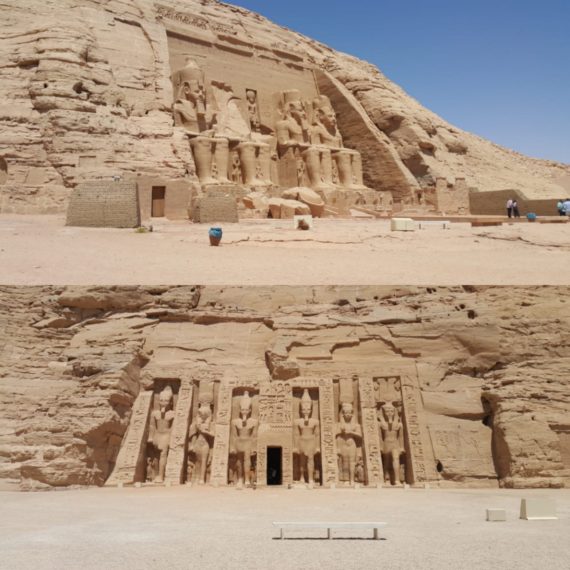 The ‘mountains’ now sheltering the temples are artificial replicas, made of poured concrete. The carved statues and walls were cut out and relocated, and an artificial mountain was built around them.
The ‘mountains’ now sheltering the temples are artificial replicas, made of poured concrete. The carved statues and walls were cut out and relocated, and an artificial mountain was built around them.
Engineers’ calculations had to be precise, down to the millimeter. They needed to realign the massive structure in such a way, not only to preserve the integrity of this ancient work of art, but to replicate the special solar phenomenon, too. Due to the increased angle of elevation of the temple’s new position, the day of the solar event changed slightly. Before it had occurred on the 21st of both months; now the Sun Festival is celebrated on the 22nd.
You can watch a documentary by National Geographic on this process here.
Other footage by worldswonders.
.
Getting There
By car
From Aswan on the north of Lake Nasser, it’s a three-hour drive across the desert to reach Abu Simbel. Fortunately, the road is well-maintained and easy to travel. Tour groups regularly make the trip out; you can arrange a trip from most any hotel or travel company in Aswan. I recommend booking a private tour. (A private car/driver plus professional tour guide cost two of us a little less than 1500 LE, April 2018.)
Or, you can simply rent a car and make the drive yourself. The road is well-marked, in great condition, and with plenty of military checkpoints along the way for security. However, this option may not always be available for foreigners, due to ever-changing security policies. Check with your embassy for current, official travel policies.
By plane
Alternatively, a small airport is located in the town of Abu Simbel. Limited flights travel to and from Aswan a few days each week. (Flights from Cairo generally make a quick stop at the airport in Aswan and then continue to Abu Simbel. Flight time from Cairo to Aswan is just over an hour, and from Aswan to Abu Simbel, 45 minutes.)
By boat
Finally, you have the option to book a luxurious 4 or 5 day cruise along Lake Nasser from Aswan to Abu Simbel. Boats range from multi-deck cruise ships to private and semi-private Dahabiya sailboats.
Hours and Cost
Hours
Abu Simbel is open daily, from 5 am to 6 pm.
Ticket prices (As of April, 2018)
- For Egyptians – 10 LE per person, 5 LE for a student with ID.
- For Foreigners – 240 LE per person; 120 LE for a student with ID.
Good to Know
Most people just do a day-trip to Abu Simbel from Aswan. But there are a few small hotels and lodgings in the town of Abu Simbel, for a possible extended stay. Staying overnight may also make it easier to arrive for the 5 am park opening. This way you can greet the rising sun’s rays as they first hit the temple.
Regarding photography: Signs posted everywhere say photography inside the temples isn’t allowed. However, you can purchase a special ticket at the entrance to be able to use your camera. (Just remember to not use flash, to protect the ancient artwork.) Unofficially, you can also tip the guy sitting at the temple door and he’ll let you snap a few shots.
A sound and light show begins at 6:15 pm from October through April, and 7:15 pm from May through September. Colorful lights are projected onto the exterior of the temple, accompanied by classical music. Though the show may be of interest to some (perhaps groups with children?) personally, I don’t recommend it. The ancient artistry is breath-taking on its own, without the added modern gimmickry. Also, unless you’re with a large tour group, arranging to see the show can be a hassle; according to the reservation website, the show is only held if a certain number of reservations are made.
For food: a restaurant/cafe is available at the site for meals and snacks. A full meal (delicious roasted chicken with a salad, vegetables, rice, and fries) cost 120 LE as of April, 2018.
While in Abu Simbel don’t miss out on visiting the beautiful cities of Luxor & Aswan, here is a comprehensive guide to their best temples.
References and Further Information:
- Abu Simbel – UNESCO campaign.
- Egyptian Gods – The Complete List. Ancient History Encyclopedia.
- Transcript of remarks, UNESCO rededication ceremony of Abu Simbel, 1968.
This post contains some affiliate links, by booking through these links, we will get a small commission that will help us maintain this site and make it grow, at no extra cost to you.
We hope you really liked this blog post! If you want to ask us any questions, or engage with other people, join our Facebook group here.
Leave a Reply
You must be logged in to post a comment.
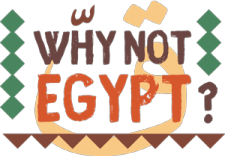
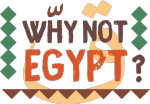

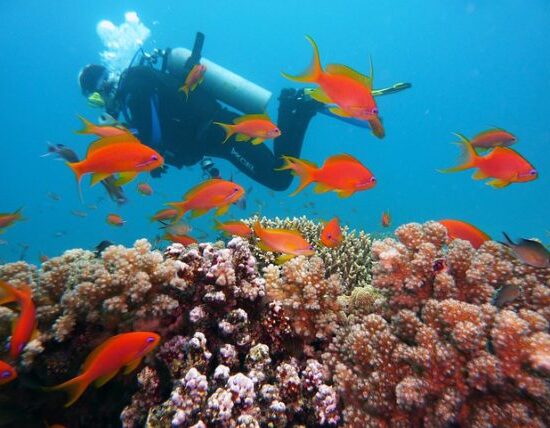
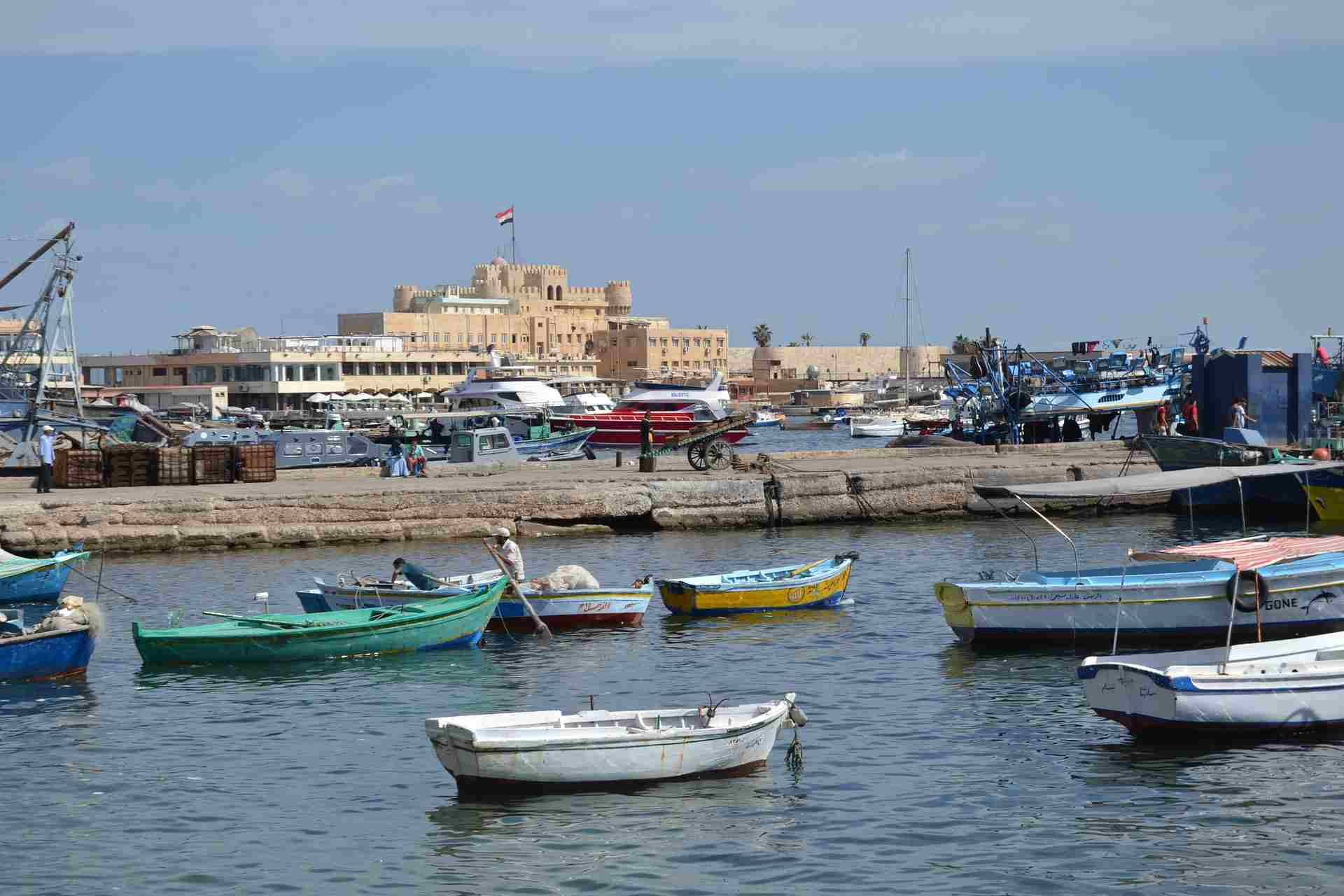
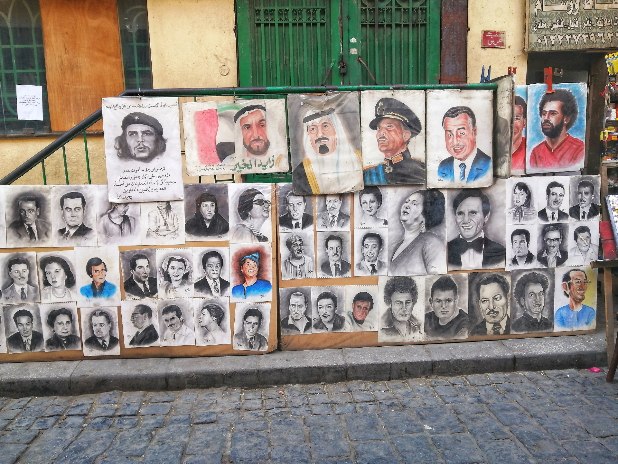

Pingback: Egypt Trains - Sleeper Train to Luxor/Aswan: Yes or No? - WhyNotEgypt?
Pingback: Ancient Egypt 101 - A Short History Lesson - WhyNotEgypt?
Pingback: Safety in Egypt: Expectations vs. Reality | Whynotegypt